The Linko Software can create and maintain Sampling Schedules which are used in the Frequency Reports in Compliance Assistant. When used with the Sampling Assistant Module, these schedules allow the automatic creation of Chains of Custody.
This process begins by the software user going to each IU, one at a time, and clicking on the Create Schedule button. The software creates a database table that includes both Authority and Industrial User Sampling records based on the frequencies assigned in the Parameter Limits for the Industrial User’s Monitoring Point.
As a final step this process creates Sampling and Frequency Reports in Compliance Assistant for both the POTW / Authority and for the Industrial User itself. These reports can be used for Compliance purposes to determine what Samples were done versus the number of Samples that should have been done.
The software keeps the Sampling Schedule, and the Chain of Custody Events list (Sampling Assistant Users only) up to date on a daily basis, so that once created, it stays current without further action on the part of the user.
Process for setting up the Sample / COC Scheduling
What Sampling
Frequencies do you use?
The first step is to determine which Sampling frequencies you use in your Sampling Program. Typical examples of Sampling frequencies are (this list is not meant to all inclusive):
Weekly
Monthly
Quarterly
Semi-Annual
Annual
Make a list of the Sampling frequencies that you use in your program.
Go to Event Administration and click on the Frequency tab. Check to make sure that all the frequencies you use in your program are listed under the Frequency tab. If necessary, add new Frequencies to the list by clicking on the Add New selection
What Sample Types do
you use?
The second step would be to determine what Sample Types you use in your Sampling Program. Typical examples of Sample Types are:
Auth_Samp Authority Sampling Event
IU_Samp Sample collected by Industrial User
Other Other type of sampling
Make a list of the Sample Types you use in your program.
Go to Event Administration and click on the Samples tab. Check to make sure that all the Sample Types you use in your program are listed under the Samples tab. If necessary, add new Sample types to the list by clicking on the Add New selection.
What Collection
Methods do you use?
The third step would be to determine what Sample Collection Methods you use in your Sampling Program. Typical examples of Collection Methods are:
Grab
24 hour composite
Make a list of the Collection Methods you use in your program.
Go to Samples and Results Administration and click on the Collection Methods tab. Check to make sure that all the Collection Methods you use in your program are listed under the Collection Methods tab. If necessary, add new Methods to the list by clicking on the Add New selection.
Configure the Sample /
COC Scheduler:
Next you have to set up several configurations for the Linko Software to be able to do the Sample / COC Scheduling. These steps will only need to be done once.
I. For each Event Frequency under Event Administration:
A. From the Frequency Tab in Event Administration, click on the Details for one of the Frequency Codes in your list.
B. Click on Edit.
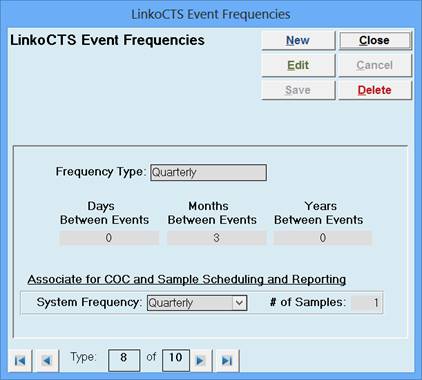
C. Select a System Frequency and # of Samples under the “Associate for COC and Sample Scheduling and Reporting” section.
D. System frequencies give the software control over the number of days and months between events for creating a Sampling schedule.
E. Identifying the number of samples is needed so that the software can validate how many samples were required during a sampling period and how many were actually taken.
F. Click Save to complete. Then Close to exit the window.
G. Complete these steps for each one of the
Sample Frequencies in your program.
II. For each Sample Event Type in Event Administration:
A. From the Samples tab in Event Administration, click on the Details for one of the Sample Types in your list.
B. Click on Edit.

C. The “Associate for COC and Sample Scheduling and Reporting” section allows the user to configure whether or not the Sample Event Type chosen is used in the Compliance Assistant Frequency and Sampling Reports. In addition, it chooses to count the Sample Type as an IU (sample made by the Industrial User), AUTH (sample made by the POTW / Authority) or both.
D. Make an appropriate selection for the Sample Event Type.
E. Click Save to complete. Then Close to exit the window.
F. Complete these steps for each one of the
Sample Event Types in your program.
III. For each Collection Method type under Samples and Results Administration:
A. From the Collection Methods tab in Event Administration, click on the Details for one of the Collection Methods in your list.
B. Click on Edit.
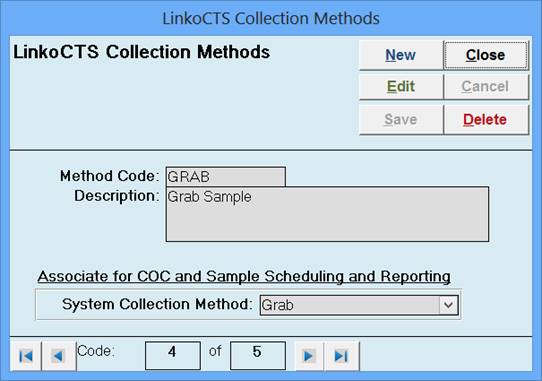
C. The “Associate for COC and Sample Scheduling and Reporting” selection is needed to configure a span of days for scheduling Samples. Select a System Collection Method relative to the type of Collection Methods. For example, a Composite Collection Method will have a System Collection Method of Composite with a Days Span of 2.
D. Make an appropriate selection.
E. Click Save to complete. Then Close to exit the window.
F. Complete these steps for each one of the
Collection Methods in your program.
IV. Determine the Date Range that you want to schedule Sampling for and configure it in the Software.
A. From the Configurations Tab in Samples and Results Administration:
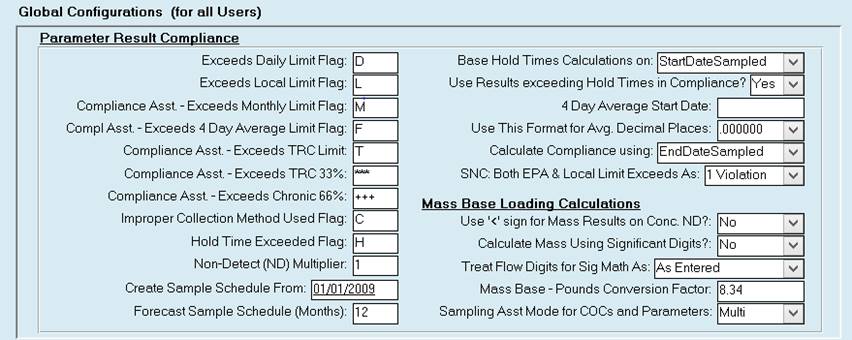
B. Find the “Create Sample Schedule From:” field.
1. This is a date field that is the Beginning date that Linko will use for Scheduling COCs. Schedules will be created no further back than this date.
C. Find the “Forecast Sample Schedule (Months)” field.
1. Enter the number of months into the future for the schedule to create COCs. Linko will automatically refresh the list and keep it current into the future for that length of time. This affects how many future Events are created on the listings.
a. When just setting up the software, the number of months into the future will be counted from the day you are doing the configuration.
Using the Create Schedule Tool to Create a Sampling Schedule
I. Choose an Industry to schedule Samples and confirm that the Parameter Limits are configured properly
A. Ensure that the Limits are entered with desired frequencies for both:
IU Sample Frequency
Auth Sample Frequency
B. Go to the Monitoring Points tab in Industries for the Industry you want to set up the schedule for.
C. Under the Parameter Limits section, scroll through the Parameter Limits, examining the IU Sample Frequency column, and the Auth Sample Frequency column.
![]()

The exact values will depend on your program and the Industry’s permit.
II. At the top of the Monitoring Point Details screen, click on the Create Schedule button.
![]()
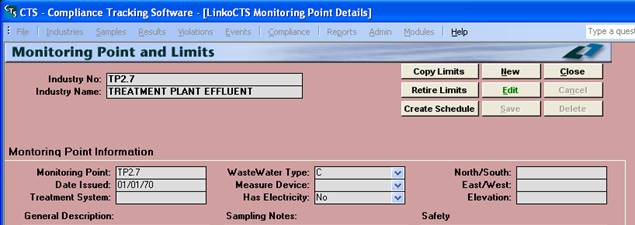
A. You will receive a confirmation dialog window.
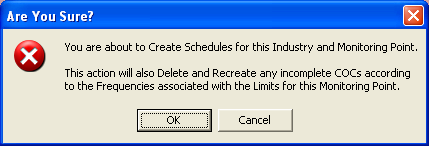
Click OK to continue.
III. Use Compliance Assistant to view these reports:
Authority Sampling Violations
Authority Frequency Violations
IU Sampling Violations
IU Frequency Violations
Tips on Using the Create
Schedule tool
I. Sampling scheduling is available only for the LinkoCTS software.
II. If an Industry has been configured for the value of “NO” under the Account Info tab for the field “Active Industry”, the Create Schedule is NOT available.
III. Clicking on the Create Schedule button recreates any previously existing schedules.
A. When creating a new schedule, and limit frequencies, effective dates, or retire dates have changed in such a manner that the schedule will be different, the new records will be created based upon the changed values.
IV. When Should I Click the Create Schedule Button?
A. When to Click
1. When limit Authority or IU Frequencies, Effective Dates, Retire Dates have changed
2. When new limits are added (wait and click after all new limits are added)
3. When limits are deleted
B. When Not to Click
1. When a Daily, Monthly or other limit value has changed.
2. When the collection method has changed
3. When units have changed
V. Auto-Creating Schedules from Limits
A. Each day the Linko software will update the sampling schedule into the future. As each day passes the software identifies if the next frequency sampling schedule should be created.